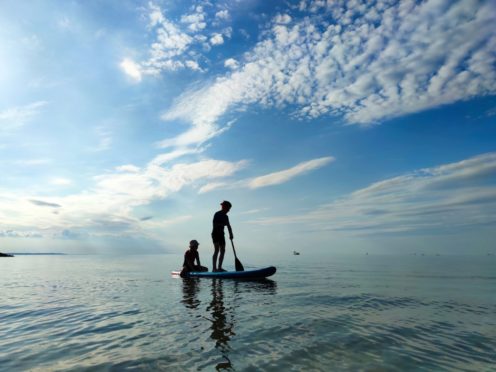
Up to 80% of emergency call-outs around Scotland’s coastlines are for paddle-boarders in trouble, figures reveal.
Stand-up paddleboarding has surged in popularity since the beginning of lockdown, with the activity now believed to be the fastest-growing water sport in the world.
However, the craze has also resulted in increasing call-outs to emergency services, prompting calls for awareness of potential dangers which can include offshore winds and quickly changing tides.
The Royal National Lifeboat Institution (RNLI) received around 20 stand-up paddleboard-related call-outs in a single week last month, accounting for about 80% of all water rescues from July 12 to 18.
The charity said there had been more call-outs in the first seven months of 2021 than in the whole of last year.
The rescues have most often been prompted by paddle-boarders getting too far from shore and being unable to overcome changing winds, tides and exhaustion.
Boris Johnson almost drowns while paddle boarding during Scotland visit
In May, eight people including five children were rescued after a dinghy and paddle-boarders got into difficulty a mile off the coast of East Lothian.
The dinghy had gone to the aid of two paddle-boarders but then capsized. Those involved were rescued by the RNLI and no one was injured.
Stand-up paddleboards, or SUPs, typically can be bought for a few hundred pounds, compared to the several thousands of pounds it can cost to get involved in similar water sports such as sea-kayaking.
SUP companies across Scotland have reported being inundated with inquiries and the number of participants is said by the RNLI to have grown exponentially since the start of last year.
William MacLean, centre principal at Wild Diamond Watersports, on the Isle of Tiree, said: “Stand-up paddleboarding is currently the fastest-growing water sport on the planet. But I would say to people, if they are beginners, to get a lesson from a trained instructor.
“After that, there are three basic points, which are to check the weather forecast before you go, make sure someone knows where and when you are going and don’t paddle alone.”
Paddle boarding popularity
Audrey Power, who runs Kayak and SUP Hire and Sales, with a base at St Mary’s Loch in the Borders, said: “Paddleboarding has grown massively and it’s easy to learn, affordable and sociable. It’s great for mental health and mindfulness.
“On the board, you are just concentrating on staying there to start with. However, people using boards should also be aware of their environment when they enter the water.
“Paddleboarding on a loch is probably safest, as it’s a more controlled environment, while paddleboarding on reservoirs, rivers and seas can add extra danger.
“We don’t allow anyone to go out without a buoyancy aid, under-16s must be with an adult and our training includes looking at weather forecasts so we know wind direction and speed.
“I would always recommend newcomers take a lesson on how to keep safe on the water.”
In unrelated tragedies last month, six people drowned in four separate water-related incidents within 24 hours in Scotland, during a spell of particularly warm weather.
Paddle Boarding Dangers
Laura Erskine, RNLI water safety education manager for Scotland, said: “As an activity, stand-up paddleboarding has grown exponentially over the last 18 months. As fun as it looks, the dangers are very real.
“Whether you are a complete beginner or more experienced, it’s always useful to know a few tips and tricks and, if you can, always go with a friend.
“Keeping your phone in a waterproof pouch protects it and people should check the weather forecast and tide times.”
Erskine also warned of offshore winds which can quickly blow a paddleboard far out to sea and make it difficult to paddle back to shore.
British Canoeing, the governing body for paddle sports, has welcomed 14,000 new members in the past 12 months alone.
It recommends use of buoyancy aids, as well as a leash which ensures a board stays close by if a paddler falls off.

Enjoy the convenience of having The Sunday Post delivered as a digital ePaper straight to your smartphone, tablet or computer.
Subscribe for only £5.49 a month and enjoy all the benefits of the printed paper as a digital replica.
Subscribe